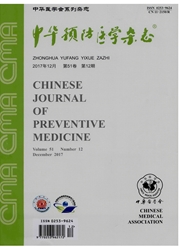

 中文摘要:
中文摘要:
目的 探讨21种金属离子浓度在PM2.5和人体晨尿中的相关关系,为阐明尿中金属的主要暴露来源提供证据。方法 于2011年4—5月招募了在本地居住5年以上、年龄在18到80岁的3 035名武汉市社区居民,从中采用单纯随机抽样法抽取120名居民组成固定群组,对其中研究对象进行问卷调查、采集静脉血并收集其清晨尿样,进行体格检查排除变量缺失个体后,最终得到83名调查对象。采用个体采样器连续24 h采集研究对象暴露的PM2.5浓度;采用电感耦合等离子体质谱仪测定颗粒物和尿中铝、钛、钒、铬、锰、钴、镍、铜、锌、砷、硒、铷、锶、钼、镉、锡、锑、钡、钨、铊和铅共21种金属离子浓度。采用线性回归模型分析21种金属在研究对象个体中的PM2.5暴露水平和尿中金属浓度的相关关系。结果 研究对象年龄为(51.5±6.3)岁。校正年龄、性别、BMI、吸烟状态、文化程度以及收入水平后,随着个体PM2.5中铬暴露水平的升高,尿中铬浓度也呈升高趋势,低铬暴露组(〈12.491 ng/m3)、中铬暴露组(12.491~32.388 ng/m3)、高铬暴露组(〉32.388 ng/m3)对象的尿铬浓度分别为(-1.334±0.756)、(-1.114±0.813)和(-0.718± 0.645)μg/mmol肌酐(P=0.009),经过校正多重比较后,尿铬与PM2.5中铬的相关性差异没有统计学意义(P=0.129)。本研究发现其他20种金属离子在PM2.5与尿中金属值差异没有统计学意义(P值均〉0.05)。结论 人体尿中排泄的金属离子可能并不主要来源于空气暴露。
 英文摘要:
英文摘要:
Objective To investigate the associations between 21 metals in fine particulate matter (PM2.5) and their corresponding concentrations in urine in the general population.Methods Between April and May 2011, this panel study enrolled 120 residents using random sampling approach in Wuhan communities which contained 3 035 subjects. Participants were aged 18 to 80 years and had lived in the sampling buildings for at least 5 years. Data from basic questionnaires, physical examinations, and morning blood and urine samples under fasting conditions were collected. Participants with missing data were excluded. Finally, 83 particpants included. Participants were instructed to use personal air samplers to continuously monitor PM2.5 for 24 h. The following 21 metals were measured in PM2.5 and urine by inductively coupled plasma mass spectrometry: aluminum, titanium, vanadium, chromium, manganese, cobalt, nickel, copper, zinc, arsenic, selenium, rubidium, strontium, molybdenum, cadmium, tin, antimony, barium, tungsten, thallium and lead. The associations between PM2.5 metals and urinary metals were investigated using generalized linear regression models.Results The age of the study population was (51.5±6.3)years. After adjusting for age, sex, smoking status, BMI, education and income, elevated urinary chromium was significantly associated with increased chromium concentrations in personal PM2.5. The least square means (standard deviation) of urinary chromium in participants classified as having low exposure (〈12.491 ng/m3), intermediate exposure (12.491-32.388 ng/m3) and high exposure (〉32.388 ng/m3) were (-1.334±0.756), (-1.114±0.813) and (-0.718±0.645) μg/mmol creatinine, respectively (P=0.009). However, the association between urinary and personal PM chromium was not observed after additionally adjusting for false discovery rate (P〉0.05). Furthermore, the results demonstrated that other metals in PM2.5 were not related to their corresponding concentrations in urine
 同期刊论文项目
同期刊论文项目
 同项目期刊论文
同项目期刊论文
 期刊信息
期刊信息
